Impact of Chirality on the Dynamic Susceptibility of Concentric Nanotori
Abstract
1. Introduction
2. Micromagnetic Simulations
3. Results
4. Conclusions
Author Contributions
Funding
Data Availability Statement
Conflicts of Interest
Appendix A

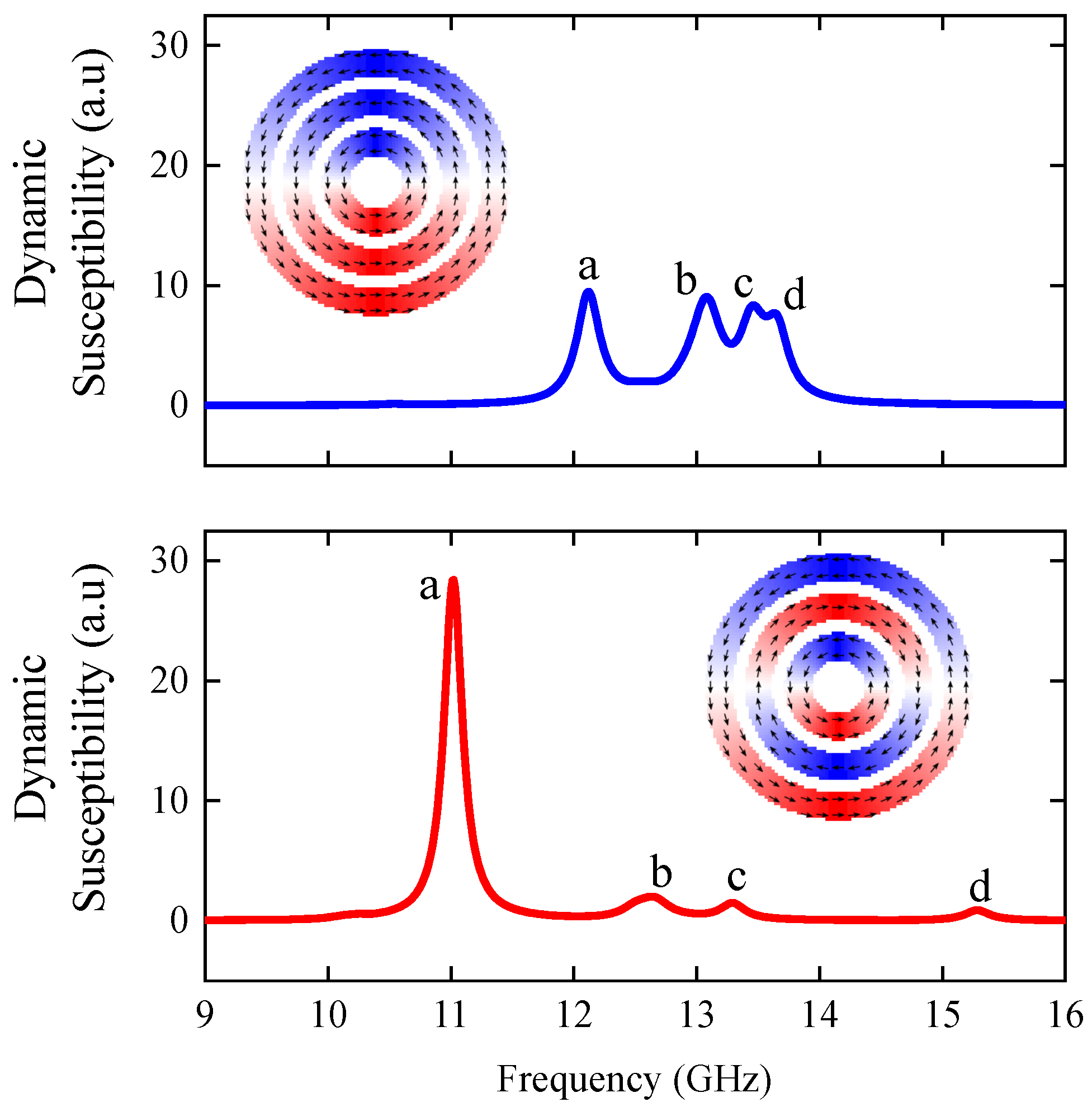

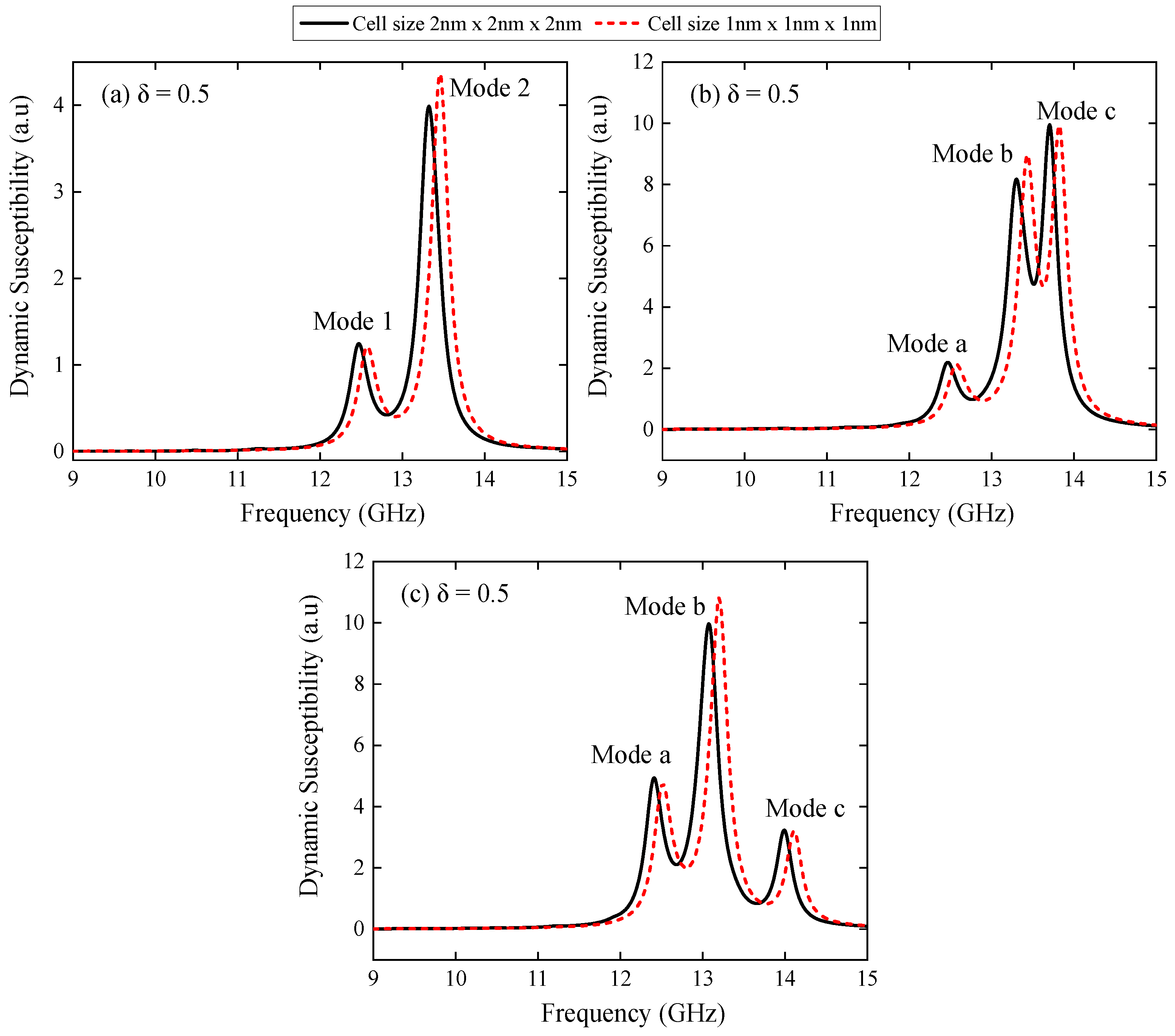
References
- Aliev, F.G.; Sierra, J.F.; Awad, A.A.; Kakazei, G.N.; Han, D.-S.; Kim, S.-K.; Metlushko, V.; Ilic, B.; Guslienko, K.Y. Spin waves in circular soft magnetic dots at the crossover between vortex and single domain state. Phys. Rev. B 2009, 79, 174433. [Google Scholar] [CrossRef]
- Madami, M.; Tacchi, S.; Gubbiotti, G.; Carlotti, G.; Montoncello, F.; Capuzzo, G.; Giovannini, L.; Nizzoli, F.; Tanigawa, H.; Ono, T. Spin Modes in Elliptical Nanorings in the Vortex State: Two-Dimensional Mapping by Micro-Focused Brillouin Light Scattering. IEEE Trans. Magn. 2010, 46, 199–202. [Google Scholar] [CrossRef]
- Awad, A.A.; Guslienko, K.Y.; Sierra, J.F.; Kakazei, G.N.; Metlushko, V.; Aliev, F.G. Precise probing spin wave mode frequencies in the vortex state of circular magnetic dots. Appl. Phys. Lett. 2010, 96, 012503. [Google Scholar] [CrossRef]
- Pan, J.; Zhang, Y.-F.; Zhang, Y.-Y.; Du, S. Engineering Two-Dimensional Magnetic Heterostructures: A Theoretical Perspective. Nano Lett. 2024, 24, 14909–14923. [Google Scholar] [CrossRef]
- Avila, J.I.; Tumelero, M.A.; Pasa, A.A.; Viegas, A.D.C. Magnetoresistive system with concentric ferromagnetic asymmetric nanorings. J. Appl. Phys. 2015, 117, 103901. [Google Scholar] [CrossRef]
- McKeever, C.; Ogrin, F.Y.; Aziz, M.M. Dynamic susceptibility of concentric permalloy rings with opposite chirality vortices. J. Appl. Phys. 2017, 121, 203901. [Google Scholar] [CrossRef]
- Mu, C.; Jing, J.; Dong, J.; Wang, W.; Xu, J.; Nie, A.; Xiang, J.; Wen, F.; Liu, Z. Static and dynamic characteristics of magnetism in permalloy oval nanoring by micromagnetic simulation. J. Magn. Magn. Mater. 2019, 474, 301–304. [Google Scholar] [CrossRef]
- Sahu, R.; Kotti, A.P.; Tandon, P.; Mishra, A.C. Static and dynamic magnetic characteristics in concentric permalloy nanorings. J. Magn. Magn. Mater. 2023, 581, 170973. [Google Scholar] [CrossRef]
- Zhang, B.; Lu, P.; Tabrizian, R.; Feng, P.X.-L.; Wu, Y. 2D Magnetic Heterostructures: Spintronics and Quantum Future. npj Spintron. 2024, 2, 6. [Google Scholar] [CrossRef]
- Hussain, B.; Cottam, M.G. Magnetization States and Coupled Spin-Wave Modes in Concentric Double Nanorings. Nanomaterials 2024, 14, 1594. [Google Scholar] [CrossRef]
- Kammerer, M.; Weigand, M.; Curcic, M.; Noske, M.; Sproll, M.; Vansteenkiste, A.; Van Waeyenberge, B.; Stoll, H.; Woltersdorf, G.; Back, C.H.; et al. Magnetic vortex core reversal by excitation of spin waves. Nat. Commun. 2011, 2, 279. [Google Scholar] [CrossRef] [PubMed]
- Vigo-Cotrina, H.; Urcia-Romero, S.; Guimarães, A.P. Influence of perpendicular uniaxial anisotropy on the switching of a magnetic vortex. J. Appl. Phys. 2025, 137, 013909. [Google Scholar] [CrossRef]
- Mi, S.; Shi, J.; Liu, H.; Wu, H.; Qiao, H.; Wang, J.; Dong, J.; Li, X.; Xue, J.; Wang, X.; et al. Chirality reversal of vortices induced by surface acoustic waves. APL Mater. 2025, 13, 011102. [Google Scholar] [CrossRef]
- Mayr, S.; Flajšman, L.; Finizio, S.; Hrabec, A.; Weigand, M.; Förster, J.; Stoll, H.; Heyderman, L.J.; Urbánek, M.; Wintz, S.; et al. Spin-wave emission from vortex cores under static magnetic bias fields. Nano Lett. 2021, 21, 1584–1590. [Google Scholar] [CrossRef]
- Bhattacharjee, P.; Mondal, S.; Saha, S.; Barman, S. Magnetic vortex: Fundamental physics, developments, and device applications. J. Phys. Condens. Matter 2025, 37, 13. [Google Scholar] [CrossRef]
- Romming, N.; Hanneken, C.; Menzel, M.; Bickel, J.E.; Wolter, B.; Von Bergmann, K.; Kubetzka, A.; Wiesendanger, R. Writing and deleting single magnetic skyrmions. Science 2013, 341, 636–639. [Google Scholar] [CrossRef]
- Baccarelli, I.; Bald, I.; Gianturco, F.A.; Illenberger, E.; Kopyra, J. Electron-induced damage of DNA and its components: Experiments and theoretical models. Phys. Rep. 2011, 508, 1–44. [Google Scholar] [CrossRef]
- Saavedra, E.; Palma, J.L.; Escrig, J. Dynamic susceptibility spectra of stadium-shaped and elliptical nanostructures. J. Magn. Magn. Mater. 2022, 541, 168493. [Google Scholar] [CrossRef]
- Zhang, B.; Wang, W.; Mu, C.; Liu, Q.; Wang, J. Calculations of three-dimensional magnetic excitations in permalloy nanostructures with vortex state. J. Magn. Magn. Mater. 2010, 322, 2480–2484. [Google Scholar] [CrossRef]
- Parkin, S.S.P.; Hayashi, M.; Thomas, L. Magnetic domain-wall racetrack memory. Science 2008, 320, 190–194. [Google Scholar] [CrossRef]
- Alzate-Cardona, J.D.; Sabogal-Suárez, D.; Restrepo-Parra, E. Magnetization switching process in a torus nanoring with easy-plane surface anisotropy. J. Magn. Magn. Mater. 2017, 442, 231–235. [Google Scholar] [CrossRef]
- Terashima, K.; Suzuki, K.; Yamaguchi, K. Monte Carlo simulation for thermal assisted reversal process of micro-magnetic torus ring with bistable closure domain structure. Phys. B Condens. Matter 2016, 486, 52–56. [Google Scholar] [CrossRef]
- Vojkovic, S.; Núñez, Á.S.; Altbir, D.; Carvalho-Santos, V.L. Magnetization ground state and reversal modes of magnetic nanotori. J. Appl. Phys. 2016, 120, 033901. [Google Scholar] [CrossRef]
- Vojkovic, S.; Carvalho-Santos, V.L.; Fonseca, J.M.; Núñez, Á.S. Vortex-antivortex pairs induced by curvature in toroidal nanomagnets. J. Appl. Phys. 2017, 121, 113906. [Google Scholar] [CrossRef]
- Mishra, A.C.; Giri, R. Micromagnetic simulation study of magnetization reversal in torus-shaped permalloy nanorings. Int. J. Mod. Phys. B 2017, 31, 1750162. [Google Scholar] [CrossRef]
- Lewis, G.R.; Loudon, J.C.; Tovey, R.; Chen, Y.-H.; Roberts, A.P.; Harrison, R.J.; Midgley, P.A.; Ringe, E. Magnetic vortex states in toroidal iron oxide nanoparticles: Combining micromagnetics with tomography. Nano Lett. 2020, 20, 7405–7412. [Google Scholar] [CrossRef]
- XianYu, Z.-N.; Du, A. Dynamic susceptibility in torus nanoring with canted external DC magnetic field. J. Magn. Magn. Mater. 2020, 511, 166955. [Google Scholar] [CrossRef]
- Corona, R.M.; Saavedra, E.; Castillo-Sepúlveda, S.; Escrig, J.; Altbir, D.; Carvalho-Santos, V.L. Curvature-induced stabilization and field-driven dynamics of magnetic hopfions in toroidal nanorings. Nanotechnology 2023, 34, 165702. [Google Scholar] [CrossRef]
- Saavedra, E.; Altbir, D.; Escrig, J.; Castillo-Sepúlveda, S.; Corona, R.M.; Carvalho-Santos, V.L. Exploring hopfion stability and dynamics in ring-like structures. Results Phys. 2024, 62, 107835. [Google Scholar] [CrossRef]
- Vansteenkiste, A.; Leliaert, J.; Dvornik, M.; Helsen, M.; Garcia-Sanchez, F.; Van Waeyenberge, B. The design and verification of MuMax3. AIP Adv. 2014, 4, 107133. [Google Scholar] [CrossRef]
- Wong, D.W.; Gan, W.L.; Teo, Y.K.; Lew, W.S. Heating Efficiency of Triple Vortex State Cylindrical Magnetic Nanoparticles. Nanoscale Res. Lett. 2019, 14, 324. [Google Scholar] [CrossRef] [PubMed]
- Garrido-Tamayo, M.-A.; Saavedra, E.; Saji, C.; Guevara, U.; Pérez, L.M.; Pedraja-Rejas, L.; Díaz, P.; Laroze, D. Stability and Spin Waves of Skyrmion Tubes in Curved FeGe Nanowires. Nanomaterials 2024, 14, 1468. [Google Scholar] [CrossRef] [PubMed]
- Castillo-Sepúlveda, S.; Corona, R.M.; Saavedra, E.; Laroze, D.; Espejo, A.P.; Carvalho-Santos, V.L.; Altbir, D. Nucleation and Stability of Toron Chains in Non-Centrosymmetric Magnetic Nanowires. Nanomaterials 2023, 13, 1816. [Google Scholar] [CrossRef]
- Fullerton, J.; Hierro-Rodriguez, A.; Donnelly, C.; Sanz-Hernández, D.; Skoric, L.; MacLaren, D.A.; Fernández-Pacheco, A. Controlled evolution of three-dimensional magnetic states in strongly coupled cylindrical nanowire pairs. Nanotechnology 2023, 34, 125301. [Google Scholar] [CrossRef]
- Lendinez, S.; Kaffash, M.T.; Heinonen, O.G.; Gliga, S.; Iacocca, E.; Jungfleisch, M.B. Nonlinear multi-magnon scattering in artificial spin ice. Nat. Commun. 2023, 14, 3419. [Google Scholar] [CrossRef]
- Kuchibhotla, M.; Talapatra, A.; Haldar, A.; Adeyeye, A.O. Magnetization dynamics of single and trilayer permalloy nanodots. J. Appl. Phys. 2021, 130, 083906. [Google Scholar] [CrossRef]
- Fassbender, J.; Von Borany, J.; Mücklich, A.; Potzger, K.; Möller, W.; McCord, J.; Schultz, L.; Mattheis, R. Structural and magnetic modifications of Cr-implanted Permalloy. Phys. Rev. B 2006, 73, 184410. [Google Scholar] [CrossRef]
- Pal, P.K.; Majumder, S.; Otani, Y.; Barman, A. Bias-Field Tunable Magnon-Magnon Coupling in Ni80Fe20 Nanocross Array. Adv. Quantum Technol. 2023, 6, 2300003. [Google Scholar] [CrossRef]
- Bhattacharjee, P.; Barman, A.; Barman, S. Spectrum of Gyrotropic Modes and Energy Transfer between Dipolar-Coupled Magnetic Vortices in a Square Lattice via Triggered Vortex Gyration: A Promise for Spintronics Technology. Adv. Quantum Technol. 2024, 7, 2300441. [Google Scholar] [CrossRef]
- Saavedra, E.; Castillo-Sepúlveda, S.; Corona, R.M.; Altbir, D.; Escrig, J.; Carvalho-Santos, V.L. Influence of curvature on the dynamical susceptibility of bent nanotubes. Results Phys. 2022, 35, 105290. [Google Scholar] [CrossRef]
- Wagner, K.; Körber, L.; Stienen, S.; Lindner, J.; Farle, M.; Kákay, A. Numerical ferromagnetic resonance experiments in nanosized elements. IEEE Magn. Lett. 2021, 12, 1–5. [Google Scholar] [CrossRef]
- Kumar, D.; Adeyeye, A.O. Techniques in micromagnetic simulation and analysis. J. Phys. D Appl. Phys. 2017, 50, 343001. [Google Scholar] [CrossRef]
- Saavedra, E.; Tejo, F.; Vidal-Silva, N.; Escrig, J. Symmetry Breaking-Induced Resonance Dynamics in Bloch Point Nanospheres: Unveiling Magnetic Volume Effects and Geometric Parameters for Advanced Applications in Magnetic Sensing and Spintronics. ACS Appl. Mater. Interfaces 2024, 16, 27605–27613. [Google Scholar] [CrossRef] [PubMed]
- Chen, W.-B.; Han, M.-G.; Zhou, H.; Ou, Y.; Deng, L.-J. Micromagnetic simulation on the dynamic susceptibility spectra of cobalt nanowires arrays: The effect of magnetostatic interaction. Chin. Phys. B 2010, 19, 087502. [Google Scholar] [CrossRef]
- Djuhana, D.; Kurniawan, C.; Kim, D.-H.; Widodo, A.T. Micromagnetic simulation of domain structure transition in ferromagnetic nanospheres under zero external field. Int. J. Technol. 2021, 12, 539–548. [Google Scholar] [CrossRef]
- Yang, J.; Kim, J.; Kim, B.; Cho, Y.-J.; Lee, J.-H.; Kim, S.-K. Vortex-chirality-dependent standing spin-wave modes in soft magnetic nanotubes. J. Appl. Phys. 2018, 123, 033901. [Google Scholar] [CrossRef]
- Otálora, J.A.; López-López, J.A.; Vargas, P.; Landeros, P. Chirality switching and propagation control of a vortex domain wall in ferromagnetic nanotubes. Appl. Phys. Lett. 2012, 100, 072407. [Google Scholar] [CrossRef]


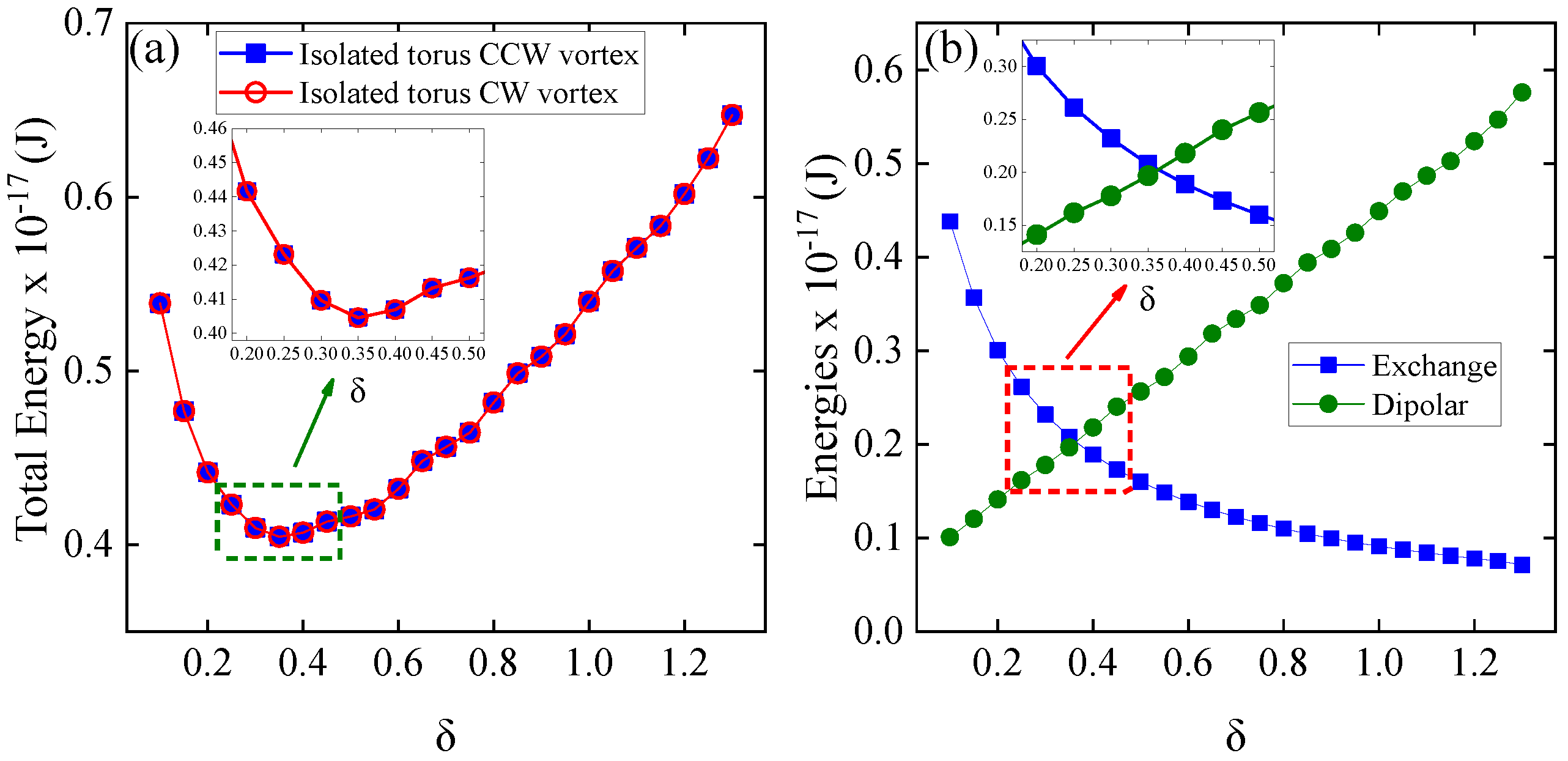

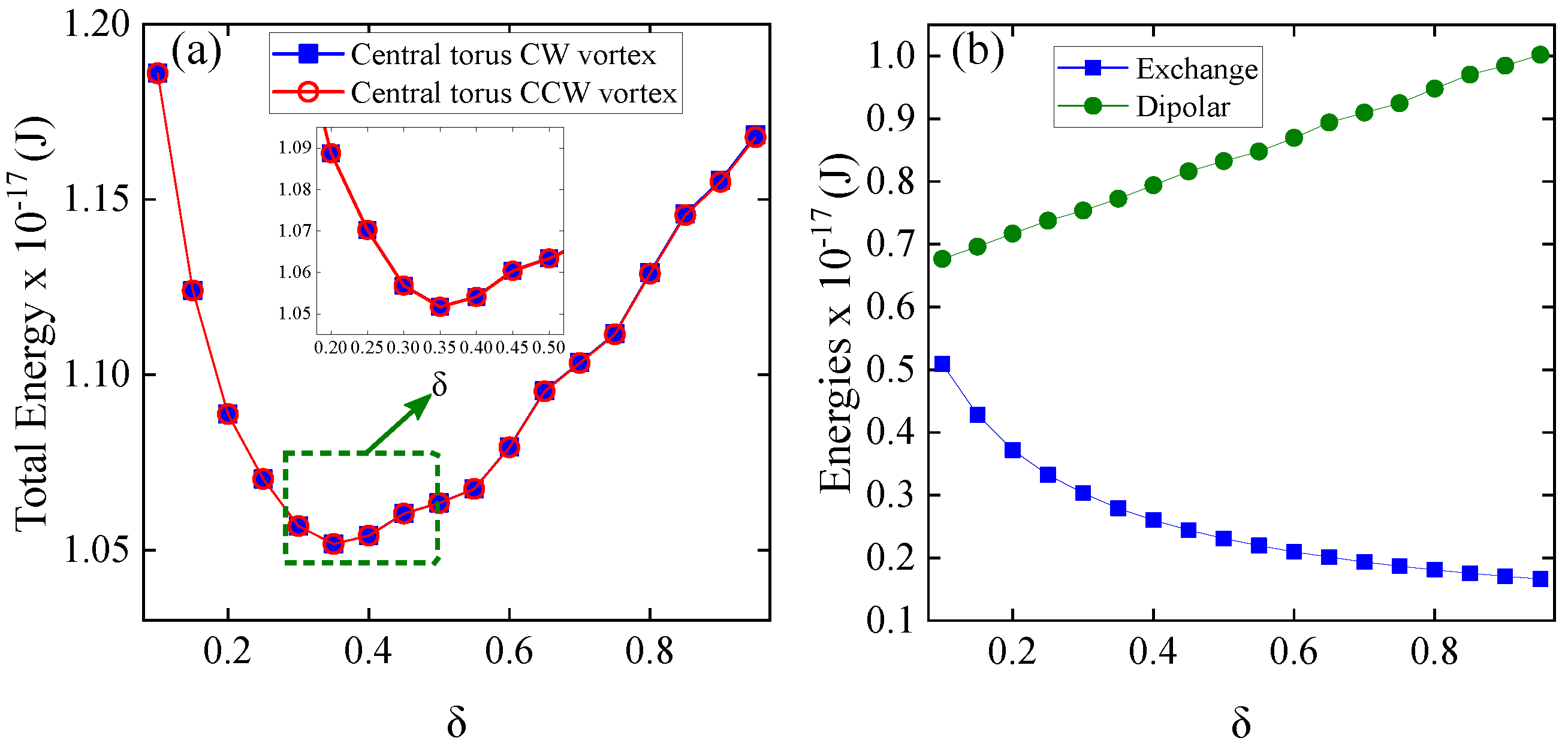
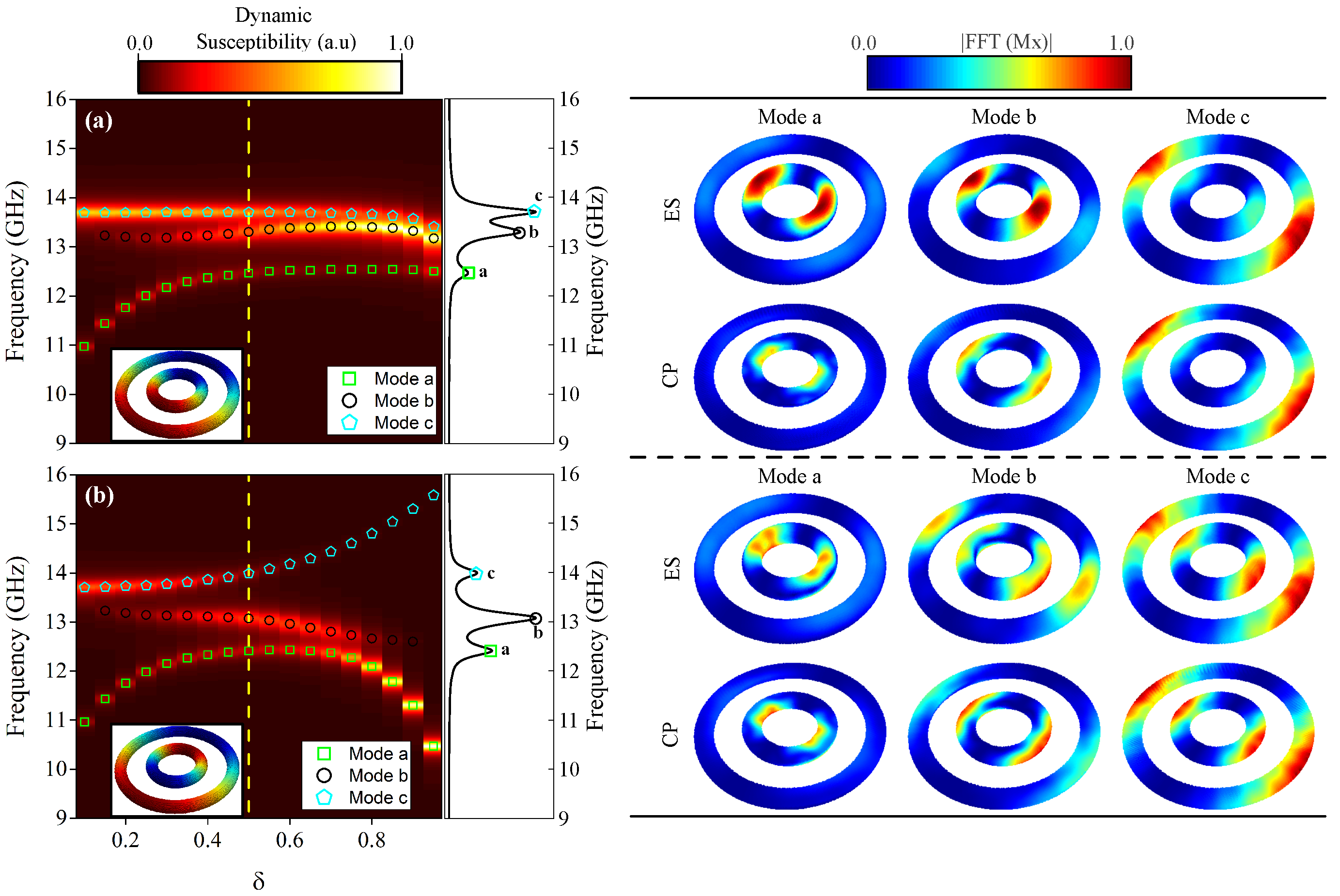
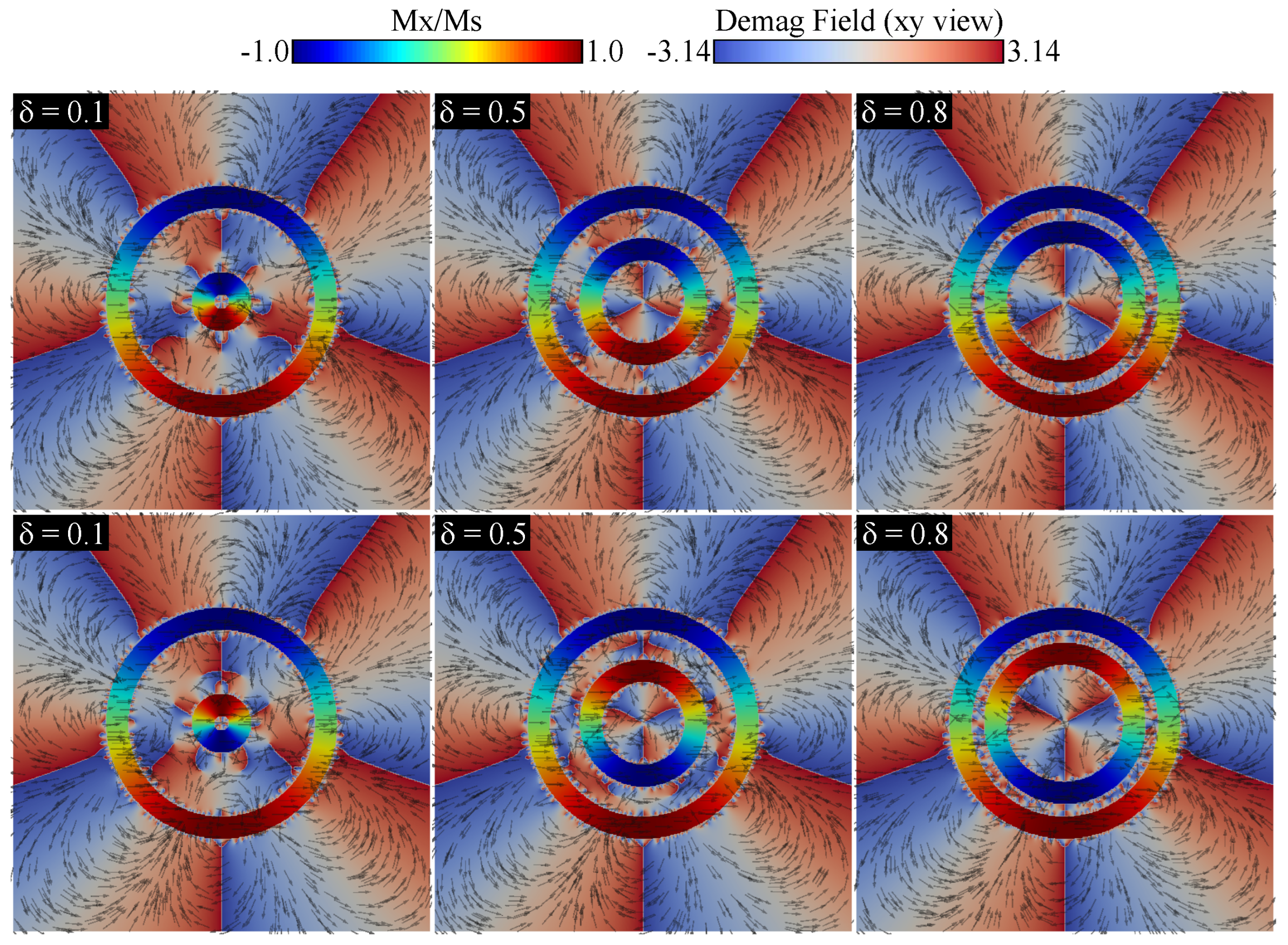
Disclaimer/Publisher’s Note: The statements, opinions and data contained in all publications are solely those of the individual author(s) and contributor(s) and not of MDPI and/or the editor(s). MDPI and/or the editor(s) disclaim responsibility for any injury to people or property resulting from any ideas, methods, instructions or products referred to in the content. |
© 2025 by the authors. Licensee MDPI, Basel, Switzerland. This article is an open access article distributed under the terms and conditions of the Creative Commons Attribution (CC BY) license (https://creativecommons.org/licenses/by/4.0/).
Share and Cite
Guevara, U.; Saavedra, E.; Pedraja-Rejas, L.; Garrido-Tamayo, M.-A.; Aranzubia, S.; Cisternas, E.; Díaz, P.; Laroze, D. Impact of Chirality on the Dynamic Susceptibility of Concentric Nanotori. Nanomaterials 2025, 15, 989. https://doi.org/10.3390/nano15130989
Guevara U, Saavedra E, Pedraja-Rejas L, Garrido-Tamayo M-A, Aranzubia S, Cisternas E, Díaz P, Laroze D. Impact of Chirality on the Dynamic Susceptibility of Concentric Nanotori. Nanomaterials. 2025; 15(13):989. https://doi.org/10.3390/nano15130989
Chicago/Turabian StyleGuevara, Ulises, Eduardo Saavedra, Liliana Pedraja-Rejas, Miguel-Angel Garrido-Tamayo, Solange Aranzubia, Eduardo Cisternas, Pablo Díaz, and David Laroze. 2025. "Impact of Chirality on the Dynamic Susceptibility of Concentric Nanotori" Nanomaterials 15, no. 13: 989. https://doi.org/10.3390/nano15130989
APA StyleGuevara, U., Saavedra, E., Pedraja-Rejas, L., Garrido-Tamayo, M.-A., Aranzubia, S., Cisternas, E., Díaz, P., & Laroze, D. (2025). Impact of Chirality on the Dynamic Susceptibility of Concentric Nanotori. Nanomaterials, 15(13), 989. https://doi.org/10.3390/nano15130989








